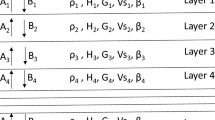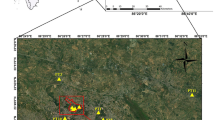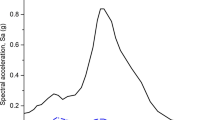Abstract
Effect of local soil in amplifying bedrock motion during earthquakes (EQs) is an important phenomenon, observed globally. As a result, even at larger distances from the epicentre, significant ground shaking and subsequent damages are witnessed. Understanding local soil effect (LSE) requires information about subsoil type as well as corresponding dynamic soil property curves (DSPCs). Though attempts have been made globally to understand local site effect, majority of such studies used DSPCs developed for other regions. In such cases, whether the outcomes represent actual surface seismic scenario for the region under study, is a matter of debate. It must be mentioned here that while the dynamic soil properties can be determined in laboratory, such findings are affected by sampling disturbance, equipment compliance etc. Downhole seismic array records on the other hand provide actual soil response during various EQs and thus are very useful in determining regional DSPCs through inverse ground response analysis (IGRA). To do IGRA, two main methodologies (based on time domain and frequency domain) exist. This work firstly presents a systematic review on existing IGRA methodologies (both time domain and frequency domain based). Later, in the light of the importance of IGRA to determine regional DSPC, few Research Questions (RQs) are framed. Answers to such RQs are then found in terms of Research Findings (RFs) from the systematic reviews highlighting the limitations of existing methodologies, importance of ground motion characteristics in different methodologies. Based on the present endevour, it is concluded that though frameworks to determine shear modulus (G) based on IGRA exist, no such framework to is available determine damping ratio (β).


Similar content being viewed by others
Abbreviations
- EQ:
-
Earthquake
- DSPC:
-
Dynamic soil property curves
- GRA:
-
Ground response analysis
- SPT:
-
Standard penetration test
- MASW:
-
Multi channel analysis of surface wave
- ELGRA:
-
Equivalent linear ground response analysis
- PGA:
-
Peak ground acceleration
- PGV:
-
Peak ground velocity
- NTU:
-
National Taiwan University
- UT:
-
University of Texas, Austin
- FIR:
-
Finite Impulse Response
References
Gazetas G, Fan K, Tazoh T, Kavadas M, Makris N. Seismic pile-group-structure interaction, In Piles under dynamic loads. ASCE
Schnabel PB (1973) Effects of local geology and distance from source on earthquake ground motions. University of California, Berkeley
Seed H, Idriss I (1970) Soil moduli and damping factors for dynamic response analysis. University of California, Berkeley
Seed HB, Idriss IM, Tokimatsu K (1986) Moduli and damping factors for dynamic analyses of cohesionless soils. J Geotech Eng ASCE 112:1016–1032
Sun JI, Golesorkhi R, Seed HB. Dynamic moduli and damping ratios for cohesive soils. Report No EERC 88–15. University of California Berkeley: 1988.
Vucetic M, Dobry R (1991) Effect of soil plasticity on cyclic response. J Geotech Eng 117:89–107
Hardin BO, Drnevich VP (1972) Shear modulus and damping in soils: Design equation and curves. J Soil Mech Found Eng Div 98:667–691
Kokusho T (1980) Cyclic triaxial test of dynamic soil properties for wide strain range. Soils Found 3:305–312. https://doi.org/10.1016/0148-9062(81)91053-6
Darendeli MB (2001) Development of a new family of normalized modulus reduction and material damping curves. University of Texas at Austin, Austin, Texas
Zhang J, Andrus R, Juang C (2005) Normalized shear modulus and material damping ratio relationships. Geotech Geoenvironl Eng 131:453–464. https://doi.org/10.1061/(ASCE)1090-0241(2005)131
Anbazhagan P, Prabhakaran A, Madhura H, Moustafa SSR, Al-Arifi NSN (2017) Selection of representative shear modulus reduction and damping curves for rock, gravel and sand sites from the KiK-Net downhole array. Nat Hazards 88:1741–1768. https://doi.org/10.1007/s11069-017-2944-x
Hanumantharao C, Ramana GV (2008) Dynamic soil properties for microzonation of Delhi. India J Earth Syst Sci 117:719–730
Lee CJ, Sheu SF (2007) The stiffness degradation and damping ratio evolution of Taipei silty clay under cyclic straining. Soil Dyn Earthq Eng 27:730–740
Okur DV, Ansal A (2007) Stiffness degradation of natural fine grained soils during cyclic loading. Soil Dyn Earthq Eng 27:843–854
Wang GX, Kuwano J (1999) Modeling of strain dependency of shear modulus and damping of clayey sand. Soil Dyn Earthq Eng 18:463–471
Yamada S, Hyodo M, Orense R, Dinesh SV, Hyodo T (2008) Strain-dependent dynamic properties of remoulded sand-clay mixtures. J Geotech Geoenviron Eng 134:972–981
Bayat M, Ghalandarzadeh A (2020) Modified models for predicting dynamic properties of granular soil under anisotropic consolidation. Int J Geomech 20:1–15. https://doi.org/10.1061/(ASCE)GM.1943-5622.0001607
Elgamal AW, Lai T, Yang Z, He L. (2001) Dynamic soil properties, seismic downhole arrays and applications in practice (CD-ROM). Proceedings of Forth International Conference on Recent Advanced Geotechnical Earthquake Engineering and Soil Dynamics pp 26–31.
Chang CY, Mok CM, Memebers A, Tang HT (1996) Inference of dynamic shear modulus From Lotung downhole data. J Geotech Eng 122:657–665
Archuleta RJ, Steidl JH, Bonilla LF. (2000) Engineering insights from data recorded on vertical arrays. Proceedings of 12th World Conference on Earthquake Engineering pp 1–7.
Baise LG, Glaser SD (2000) Consistency of ground-motion estimates made using system identification. Bull Seismol Soc Am 90:993–1009. https://doi.org/10.1785/0119980169
Elgamal AW, Zeghal M, Tang HT, Stepp JC (1995) Site dynamic properties I: evaluation of site dynamic properties. J Geotechn Eng 121(4):350–362
Harinarayan NH, Kumar A (2018) Seismic site classification of recording stations in Tarai region of Uttarakhand, from multiple approaches. Geotech Geol Eng 36:1431–1446. https://doi.org/10.1007/s10706-017-0399-1
Kumar A, Baro O, Harinarayan NH (2016) Obtaining the surface PGA from site response analyses based on globally recorded ground motions and matching with the codal values. Nat Hazards 81:543–572. https://doi.org/10.1007/s11069-015-2095-x
Kumar A, Harinarayan NH, Baro O (2017) Nonlinear soil response to ground motions during different earthquakes in Nepal, to arrive at surface response spectra. Nat Hazards 87:13–33. https://doi.org/10.1007/s11069-017-2751-4
Chang C, Tang YK, Mok CM, Tang HT, (1991) Power MS. Development of Shear Modulus Reduction Curves Based on Lotung Downhole Ground Motion Data. 1991-Second International Conference on Recent Advanced Geotechnical Earthquake Engineering and Soil Dynamics;16: 44.
Ghayamghamian MR, Matosaka M. (2001) Identification of Dynamic Soil Properties Using Vertical Array Recordings. Proceedings of international Conference Recent Advanced Geotechnical Earthquake Engineering and Soil Dynamics.
Ghayamghamian MR, Kawakami H (1996) On the characteristics of non-linear soil response and dynamic soil properties using vertical array data in Japan. Earthq Eng Struct Dyn 25:857–870. https://doi.org/10.1002/(SICI)1096-9845(199608)25:8%3c857::AID-EQE592%3e3.0.CO;2-R
Kokusho T, Sato K, Matsumoto M. (1996) Nonlinear dynamic soil properties back-calculated from strong seismic motions during Hyogoken-Nanbu earthquake. Proceedings 11WCEE., Acapulco, Mexico, p. 2080.
Ghayamghamian MR, Kawakami H (2000) On site nonlinear hysteretic curves and dynamic soil properties. J Geotech Geoenviron Eng 2:543–555
Taboada-Urtuzuastegui V, Martinez H, Romo M, Ardila C. Identification of Mexico City Clay Dynamic Properties. Proceedings of 12th World Conference on Earthquake Engineering Auckland, New Zeal 2000; pp 1–8.
Yangisawa E, Kazama M. Nonlinear dynamic behavior of the ground inferred from strong motion array records at Kobe Port Island during the 1995 Hygo-Ken Nanbu earthquake. Procee Earthq Engg 11th World Conf Earthq Engg, 1996.
Zeghal M, Tang HT, Stepp JC (1995) Soil nonlinear properties. J Geotech Eng 121:363–378
Tang YK. (1989) Proceedings: NSF/EPRI Workshop on Dynamic Soil Properties and Site Characterization., Held in Palo Alto, California, p. Volumes 1 and 2.
Archuleta BYRJ, Seale H, Sangas PV, Baker LM, Swain ST, Glaser SD et al (2000) Consistency of ground-motion estimates made using system identification. J Struct Constr Eng (Transactions AIJ) 61:993–1009. https://doi.org/10.1017/CBO9781107415324.004
Oskay C, Zeghal M (2011) A survey of geotechnical system identification techniques. Soil Dyn Earthq Eng 31:568–582. https://doi.org/10.1016/j.soildyn.2010.11.011
Koga Y, Matsuo O (1990) Shaking table test of embankments resting on liquefiable sandy ground. Soil Found Eng 30:162–174
Lazan BJ (1968) Damping of material and members in structural mechanics. Pergamon press Ltd, Oxford, U.K
Taboada-Urtuzuástegui V, Martínez H, Romo MP (1999) Evaluation of dynamic soil properties in mexico city using downhole array records. Soils Found 39:81–92. https://doi.org/10.3208/sandf.39.5_81
Tokimatsu K, Midorikawa S. (1981) Nonlinear Soil Properties Estimated from Strong Motion Accelerograms. Proceeding 1st International Conference on Recent Advanced Geotechnical Earthquake Engineering and Soil Dynamics, pp 117–22.
Tokimatsu K, Midorikawa S, (1989) Yoshimi Y. Dynamic soil properties obtained from strong motion records. 12th International Conference Soil Mechanics and Foundation Engineering, pp 2015–8.
Tokimatsu K, Sekiguchi T, Miura H, Midorikawa S (2006) Nonlinear dynamic properties of surface soils estimated from strong motion accelerograms at K-NET and JMA stations in Ojiya. Jour Struct Constr Engg AIJ 600:43–59
Midorikawa S, Miura H. (2008) Nonlinear Behavior of Soil Response Observed In Strong-Motion Records From Recent Japanese Earthquakes. World Conference on Earthquake Engineering; p 3.
Wolf J, Obernhuber PC (1982) Free-field response from inclined SH-waves and Love-waves. Earthq Engg Struct Dyn 10:823–845
Madera GA (1970) Fundamental period and amplification of peak acceleration in layered systems. Department of Civil Engineering, M.I.T, Cambridge, Massachusetts
Schnabel PB, Lysmer J, Seed HB. (1972) SHAKE-a computer program for earthquake response analysis of horizontally layered sites. Report No. EERC, pp 72–12.
Ghayamghamian M. (2001) Identification of Dynamic Soil Properties Using Vertical Array Recordings.
Kokusho T, Matsumoto M (1998) Nonlinearity in site amplification and soil properties during the 1995 Hyogoken-Nambu earthquake. Soils Found 38:1–9. https://doi.org/10.3208/sandf.38.special_1
Ohta H. (1975) Application of optimization method to earthquake engineering (part I)-estimation of underground structure of SMAC observation site in Hachinohe Harbour. J Jpn Soc Archit Eng.
Honjo Y, Iwamoto S, Sugimoto M, Onimaru S, Yoshizawa M (1998) Inverse analysis of dynamic soil properties based on seismometer array records using the Extended Bayesian method. Soil Sci Soc Am J 38:131–143
Mondal JK, Kumar A (2021) A new frequency domain based inverse ground response analysis framework for the determination of dynamic soil properties. Int J Geomech 21:1–23. https://doi.org/10.1061/(ASCE)GM.1943-5622.0001973
Seed HB, Idriss IM (1970) Analyses of ground motion at Union Bay, Seattle during earthquakes and distant nuclear blasts. Bull Seism Soci Am 60:125–136
Shima E (1962) Modification of seismic waves in superficial layers as verified by comparative observation on and beneath the syrface. Bull Earthq Resrc Inst Tokyo 40:187–259
Denyer D, Tranfield D. Producing a Systematic Review. Sage Handb. Organ. Res. Methods. . In: Buch, London: Sage Publications.; 2009.
Anderson DG, Tang YK. Summary of soil character- ization program for the Lotung large-scale seismic experiment. Vol. 2, Rep. No. NP-6I54, Electric Power Research Institute, Palo Alto, Calif: 1989.
Mar M, Shen CK, Wang Z, Li XS, Wang Z. Pore Pressure Response During 1986 Lotung Earthquakes 1991.
Tang HT, Tang YK, Stepp JC, Wall IB, Lin E, Cheng SC et al (1989) A large-scale soil-structure interaction experiment: Design and construction. Nucl Eng Des. https://doi.org/10.1016/0029-5493(89)90248-3
Tang HT, Tang YK, Stepp JC, Wall IB, Lin E, Cheng SC et al (1989) A large-scale soil-structure interaction experiment: Design and construction. Nucl Eng Des 111:371–379. https://doi.org/10.1016/0029-5493(89)90248-3
Katayama T, Yamazaki F, Nagata S, Lu L, Turker T (1990) A strong motion database for the chiba seismometer array and its engineering analysis. Earthq Eng Struct Dyn 19:1089–1106. https://doi.org/10.1002/eqe.4290190802
Elgamal A, Lai T, Yang Z, He L, Prakash S (2001) (Ed.) Dynamic soil properties, seismic downhole arrays and applications in practice (CD-ROM). Proceedings of Forth International Conference on Recent Advanced Geotechnical Earthquake Engineering Soil Dynamics, pp 26–31.
Iwasaki Y, Tai M (1996) Geotechnical aspects of the January 17, 1995 Hyogoken-Nambu earthquake: strong motion record at Kobe Port Island. Soil Foundn Spcl Issue 1:29–40
Iwasaki T, Tokida K, Yoshida S, Tatsuoka F. (1979) Experimental studies on dynamic properties of clay. Proceedings of 14th Annual Meeting JSSMFE, pp 629–632.
Kramer SL. (1996) Geotechnical Earthquake Engineering.
Chandra J, Guéguen P, Steidl JH, Bonilla LF (2015) In situ assessment of the g–γ curve for characterizing the nonlinear response of soil: Application to the garner valley downhole array and the wildlife liquefaction array. Bull Seismol Soc Am 105:993–1010. https://doi.org/10.1785/0120140209
Eseller-Bayat EE, Ada M (2019) A methodology for estimation of site-specific nonlinear dynamic soil behaviour using vertical downhole arrays. Eur J Environ Civ Eng 10:1–23. https://doi.org/10.1080/19648189.2019.1603122
Kokusho T, Aoyagi T, Wakunami A (2005) In situ soil-specific nonlinear properties back-calculated from vertical array records during 1995 Kobe earthquake. J Geotech Geoenviron Eng 131:1509–1521. https://doi.org/10.1061/(ASCE)1090-0241(2005)131:12(1509)
Lin JS (1994) Extraction of dynamic soil properties using extended kalman filter. J Geotech Eng 120:2100–2117. https://doi.org/10.1061/(ASCE)0733-9410(1994)120:12(2100)
Tokimatsu K, Arai H. Dynamic soil properties estimated from downhole array data recorded at the Kashiwazaki-Kariwa nuclear facility in the 2007 Niigata-ken Chuetsu-oki earthquakes. Proceedings of 17th International Conference on Soil Mechanics Geotechnical Engineering Acad Pract Geotech Eng 2009; 3: 2024–2027. https://doi.org/10.3233/978-1-60750-031-5-2024.
Wang HY, Jiang WP, Wang SY, Miao Y (2019) In situ assessment of soil dynamic parameters for characterizing nonlinear seismic site response using KiK-net vertical array data. Bull Earthq Eng 17:2331–2360. https://doi.org/10.1007/s10518-018-00539-3
Kumar A, Mondal JK (2017) Newly developed MATLAB based code for equivalent linear site response analysis. Geotech Geol Eng 35:2303–2325. https://doi.org/10.1007/s10706-017-0246-4
Funding
The authors confirm that there is no funding agency available for the present research work.
Author information
Authors and Affiliations
Corresponding author
Ethics declarations
Conflict of interest
No potential conflict of interest was reported by the authors.
Additional information
Publisher's Note
Springer Nature remains neutral with regard to jurisdictional claims in published maps and institutional affiliations.
Appendices
Appendix A
NLGRA
In NLGRA, the following equation of motion (Eq. 22) is solved numerically at every time step [63]. This time step can be the default time step at which the acceleration values are recorded or some other value set for interpolation.
where \(\left[M\right]\) is the mass matrix, \(\left[C\right]\) is the viscous damping matrix, \(\left[K\right]\) is the stiffness matrix, \(\left\{\ddot{u}\right\}\) is the nodal relative acceleration vector, \(\left\{\dot{u}\right\}\) is the nodal relative velocity vector, \(\left\{u\right\}\) is the nodal relative displacement vector. \({\ddot{u}}_{g}\) is the acceleration at the base of the soil column and \(\left\{I\right\}\) is the unit vector. Further, the stiffness matrix and damping matrix are updated in each time step to incorporate nonlinear soil behavior. It should be highlighted here that thesoil behavior during an EQ loading is very complex. Depending on the developed γ levels in soil layers, G and β values change throughout the duration of EQ shaking. As γ increases, G decreases, and β increases. The values of G and β at each time step can be obtained by the use of an appropriate constitutive model (stress–strain model), the parameters of which can be adjusted based on DSPC.
ELGRA
The displacement at any point in a soil layer can be expressed as [63];
where Asis the amplitude of the upward propagating wave and Bsis the amplitude of downward propagating wave. ωis the angular frequency of loading, Zs is the depth coordinates measured in the downward direction from the top of the soil layer, \({k}_{s}^{*}\) is the complex wavenumber for soil layer, which is defined as;
Further, theγ can be estimated as,
In ELGRA, the γ value in each of the soil layers involved are estimated first using Eq. A3. While, calculating the γvalue, initially, low γcorresponding G and β values are assigned to each of the soil layers. Once, γ value is calculated, new values of G and β are selected from G/Gmax curve andβ curve, respectively based on theγ value. This way the analysis move forward until the difference between two succeeessive G and β values fall below a certain percentage. Once the G and β values for all the layers are finalized. Response in any layer can be obtained by considering the Eqations mentioned in [63, 70].
Appendix B
List of search terms
-
Downhole array
-
Modulus degradation
-
Damping
-
Ground response analysis
-
Local site effects
-
Inverse analysis
Rights and permissions
About this article
Cite this article
Mondal, J.K., Kumar, A. A Systematic Review on Inverse GRA Methodologies Developed for the Determination of Dynamic Soil Properties Using Downhole Seismic Array Records. Indian Geotech J 52, 400–415 (2022). https://doi.org/10.1007/s40098-021-00571-2
Received:
Accepted:
Published:
Issue Date:
DOI: https://doi.org/10.1007/s40098-021-00571-2




